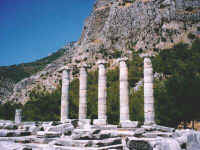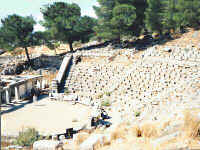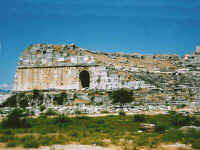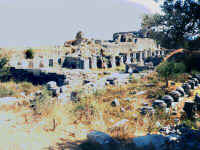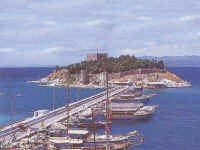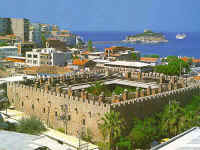|
Page 1 2 3 4 5 6 7 8 9 10 11 12 13 14 15 16 17 18 19 20 21 22 23 Monday, October 2: After breakfast at the hotel, we left Selcuk about 9:00. We stopped to see the Artemision in the sunlight. We decided not to visit the so-called "House of the Virgin Mary" partly because of the press of time, but also because we did not believe it really had any connection with her. (It was built in 1950, supposedly on the foundation of a 1st Century house, but Pope John Paul II visited it in 1979, thereby giving it some level of recognition.) We bypassed most of Kusadasi and continued south to Priene. It was described in our guidebook as "one of the best preserved Hellenistic cities in the world," with streets laid out in a perfect grid. It turned out to be a disappointment. There was little to see beside a sparsely restored Temple of Athena, a small theater (both 4th Cent. B.C.), a couple of narrow streets (straight, but not enough to be called a grid), and lots of rubble and foundations. Built on a mountainside in the 12th Century B.C., Priene never had more than 5,000 inhabitants. Its claim to fame is that Alexander the Great stayed there for a time and financed construction of the Temple of Athena. We continued south toward Miletus. It was farther than we expected and we thought we might have taken a wrong turn. We saw a group of boys from the migrant cotton picking families, and I stopped to ask if we were on the right road. They held out their hands, asking for money and acting like blathering idiots, so we drove on. Because we were in a very flat area between the mountains and the coast, we finally were able to see Miletus, still in the distance. After parking the car, we started to enter the ruins. Several gypsy boys kept confronting us, laughing and holding their fingers around their eyes (like glasses) and saying what sounded like "occhi" (Italian for "eyes"). We think they were joking about the evil eye. The ruins were not very impressive. Like Ephesus, Miletus was once a seaport but is now five miles inland due to silting from its river (the Meander). That accounts for the flatness of the land between the city and the sea. Settled as early as 1400 B.C., Miletus fell under a succession of invaders like most of the ancient coastal cities. It reached its peak in the 7th and 6th Centuries B.C., founded many colonies, and was a leading center for art and science. It declined steadily after 500 B.C., however. The 25,000 seat theater was the most massive surviving structure, the one we had seen from miles away (because the land is so flat). The Faustina Baths, the largest in Anatolia, are recognizable but not too well preserved. We also saw the Ilyas Bey Mosque (14th Cent.), in fairly good condition. There were a number of other ruins across the huge agora, but we were tired and had seen too many better ruins recently. The site would have been more attractive if it still had the massive city gate that now stands in the Pergamon Museum in Berlin. We had seen it there in the early 1970s. It was after 1:00 and we were a long way from any town, so we had lunch at one of the two restaurants at Miletus. We were getting smarter about not overeating at lunch, and we just had a couple of meses. We headed back north to Kusadasi, stopping at Diana Travel to check on ferry arrangements. When we said we wanted to be within walking distance of their office in the morning, they referred us to a pension ($20 with breakfast) just up a street so narrow Jane thought it was a pedestrian walk. Although conveniently located, this turned out to be the poorest accommodations we had on the entire trip. After unloading everything at the pension, we returned the car to Avis, glad not to have to drive any more in the city. We walked along the waterfront, then out the causeway to the restored Genoese fortress (1500 A.D.) on Bird Island. There was a great view back toward the harbor. Walking back to town, we visited the Karavansaray, built about 1613 as an inn for caravans, now beautifully restored as a fine hotel. Around the lovely fountain in the big courtyard where the camels once were kept, hundreds of high quality carpets were displayed for sale. One of the salesmen gave us the history of the building in great detail without once asking if we were interested in a carpet. (Those Turks are smoooooth!) Next, we went into the courtyard of the Okuz Mehmet Pasa Mosque (also 1613). We didn't go into the mosque itself because people were praying there. Back at the pension, Jane had an apple tea at the bar. We arranged for the clerk to wake us at 6:30 the next morning, then went to our room to rest (Jane) and sort our stuff and repack for the flight back (me). Later we changed and went out to celebrate our 42nd anniversary since we would be traveling the next day. It was windy and bitter cold, so we picked out a waterfront restaurant where we could eat inside. We picked two large sole from an aquarium for our main course. (The fish alone, sold by weight, cost more than our hotel, fish dinner, and breakfast at Assos!) We had a couple of meses, a salad, and the fish with red rice. The waiter fileted the fish at the table, just like they used to do in Italy in the early 1960s. We each had a half-liter Efes beer, and Jane had watermelon for dessert. We stopped by the Karavansaray again to see it by night. It was beautiful, with the edges of the building outlined with lights. We were freezing, though, even with our heaviest jackets, so we rushed back to our pension before 9:00. Page 1 2 3 4 5 6 7 8 9 10 11 12 13 14 15 16 17 18 19 20 21 22 23 |

